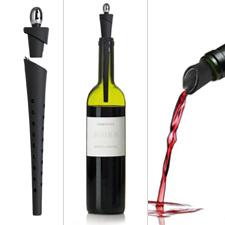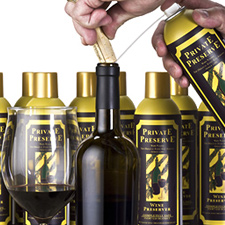If you open more than a few bottles of wine per week, it’s probably already too late.
No, I’m not talking about your health or your sanity, but about your kitchen drawers. They’re likely choked with wine paraphernalia—gizmos to open wine and to serve it, to pour it and store it; with wine charms and bottle pens and aerator thingies, plus a rainbow array of stoppers and caps.
It’s worse if your friends know you love wine, too, because it’s less intimidating to give a wine geek a tchotchke that “makes a great gift!” than to select a winning bottle.
So even if you don’t buy much of it yourself, it still marches into the house every year at the holidays, gamely helps out awhile, then hangs around the bar interminably making itself a nuisance. By February it has probably been relegated to the dusty nether reaches of your little wine world.
I’ve seen my share of the stuff. But over time, I’ve winnowed my toolkit to a few essential items. I was skeptical about much of it at first, but some finally proved their merit through repeated use.
Here are ten that earn their keep. The first nine will set you back about $200, and the last one—arguably a category unto itself—could run another $100 or more, depending on your needs. But taken together, these truly would make a great gift to a new wine drinker, although even experienced wine lovers might find something new here to love, too.
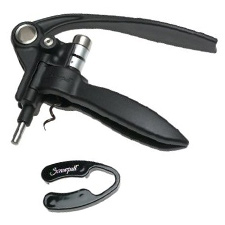 1. Lever Screwpull and capsule cutter – $80
1. Lever Screwpull and capsule cutter – $80
This was a wedding gift from our dentist (lidocaine not included). We smirked at first because it seemed so over-designed, but once we started using it, we were hooked. Its Teflon-coated worm makes swift work of opening bottles, and it’s helpful for parties when you need to open a lot of wine. (The capsule cutter is another must-have, although you can also buy these separately.) You must replace the worm periodically, and the unit isn’t great for synthetic corks or wide-mouthed bottles. For these you’ll need a standard waiter’s corkscrew—which, sure, you could use all the time. But the Screwpull is a smooth, wine-opening machine, and I like it.
 2. Waiter’s corkscrew – $5
2. Waiter’s corkscrew – $5
The standard-issue wine opener. You’ll need one of these for backup, for travel, and for any bottles the Screwpull can’t handle. Look for a curved model that’ll fit comfortably in your hand and pocket.
Sometimes a brittle cork will give you trouble. Insert the prongs of this cork puller, often called an “Ah So,” between the cork and bottle and twist gently while pulling. Although it’s impractical for regular use, it’s indispensible if you’re lucky enough to open a lot of old wine. The one shown here is on the pricey side, but you can get similar models for about $5.
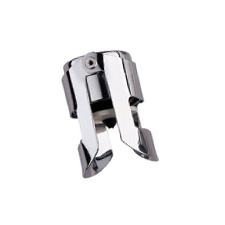 4. Sparkling wine stopper – $5
4. Sparkling wine stopper – $5
For those rare occasions when you don’t finish the bottle of bubbly, you need a topper that’ll work over pressure. A regular cork or rubber stopper gets pushed out, but a champagne stopper latches onto the bottle’s lip, preserving your bubbles for another day.
 5. Decanter – $35
5. Decanter – $35
I use our decanter for perhaps a third to a half of all wines we open, mostly reds but some whites, too. Sometimes I need it to rack an older wine off its sediment, give a fine wine time to evolve before tasting, or warm a white or red from a too-cold storage temperature. More often, though, I’m simply introducing air to a young or tight wine to open up its aromas and make it more accessible. In this way, a decanter can repay its investment by delivering more enjoyment from less expensive wine. Look for a model with a wide base that will expose a large surface area to air. I like the affordable “Allure” decanter from Wine Enthusiast, shown here. You can spend a lot more, but you’ll mostly be paying for style, not function.
When decanting is impractical, a finer and aerator can do some of this job, although a bit more aggressively than is sometimes desirable. I own a Vinturi aerator, but that requires you to pour into another vessel. The Nuance, meanwhile (shown here), sits in the neck of the bottle, providing filtration, aeration, and pouring spout in one. I like to use it at tastings and trade events, too.
 7. Oggi Wine Chiller with Freezer Inserts – $25
7. Oggi Wine Chiller with Freezer Inserts – $25
This Oggi chiller is lightweight, stylish, easy to clean, and sports slender inserts you can keep frozen. I prefer this to the heavy marble models, which take up a lot of space in my freezer. For faster chilling, add water to the bucket.
Formerly, I used to use a vacuum pump to preserve opened bottles of wine. One day it dawned on me that creating negative pressure inside a bottle of wine is a spectacularly bad idea. It’s simple physics: in a depressurized chamber, dissolved gases will be pulled out of solution. Dissolved gases in wine could rightly be called “aromatics,” and I want to preserve as many of those as I can. So I switched to Private Preserve, a blend of inert gases (nitrogen, carbon dioxide, and argon) that displaces the air in the bottle, blanketing the wine and protecting it from oxidation. One $9 can gives you about a hundred uses.
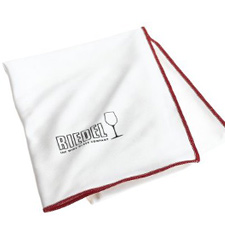 9. Riedel polishing cloth – $12
9. Riedel polishing cloth – $12
My husband discovered this one, and the reviewers claimed it made their glassware shinier. Boy, was I skeptical, but he bought one anyway, and in the spirit of discovery, did a blind test with me. Voilà! The glass was not only shinier, it was also completely spotless and lint-free. After washing in very hot water and a tiny amount of neutral detergent, invert the glasses briefly, then polish while still warm. (A word to the wise: when polishing, don’t ever take the base of a glass in one hand and turn its bowl with the other. Manufacturers tell you not to, because you can twist apart a glass this way. I know. I’ve done it. Just don’t.)
10. Glassware: Riedel Vinum Series, $18–25 per stem
Although I’ve saved it for last, good glassware is critical. While a disquisition on the merits of quality stemware is beyond the scope of this article, suffice it to say that glass shape, size, and material do significantly affect the tasting experience—an effect even new tasters can discern. Riedel’s Vinum series is extensive and well made but not crazy-stupid expensive. (You can find reasonable approximations of from Crate & Barrel if you’re on a tighter budget.) I recommend the following Vinum models, in descending order of importance:
 [box] Bordeaux – $25: The Bordeaux glass is useful for a wide range of reds, including Cabernet, Cabernet Franc, Merlot, Syrah, Côtes du Rhône, and other dense, chewy wines. It’s also good for bigger, mouth-filling whites like Viognier, white Rhônes, and some Chardonnays. A very delicate or nuanced wine can seem muted in the large bowl, but the majority of reds seem to do well with it.
[box] Bordeaux – $25: The Bordeaux glass is useful for a wide range of reds, including Cabernet, Cabernet Franc, Merlot, Syrah, Côtes du Rhône, and other dense, chewy wines. It’s also good for bigger, mouth-filling whites like Viognier, white Rhônes, and some Chardonnays. A very delicate or nuanced wine can seem muted in the large bowl, but the majority of reds seem to do well with it.
Zinfandel – $18: Primarily meant for high-acidity reds, including Zinfandel, Chianti, Sangiovese, Nero d’Avola, and similar, it’s also excellent for light-bodied, aromatic white wines like Riesling, Malvasia, and Grüner Veltliner. Versatile as a dessert wine glass, too. Its shape is a reasonable approximation of the ISO-standard tasting glass, making it somewhat all-purpose, but I recommend starting with the Bordeaux glass, because most everyday wines do better in it.
Burgundy – $25: This glass is best for lighter-bodied, aromatic red wines, especially those that need more surface area to convey their charms. I use it for Pinot Noir, including Blanc de Noirs and rosé Champagne, plus Gamay, Beaujolais, and other lighter reds.
Chablis/Chardonnay – $25: This can serve as your basic white wine glass, useful for oaked and un-oaked Chardonnay along with a broad range of other whites. Also useful for many dessert wines.
Cuvée Prestige – $20: These flutes have minuscule scribble etched in the bottom that provides a nucleating surface for bubbles, and a smaller opening that targets those fruity, toasty aromas directly at your nose. (Champagne really does go straight to your head.)[/box]
 11. Bonus! Tom’s of Maine Silly Strawberry Children’s Toothpaste – $3.75
11. Bonus! Tom’s of Maine Silly Strawberry Children’s Toothpaste – $3.75
Silly, yes, but perfect for times when you want to clean your teeth without obliterating your taste buds with minty-freshness. Because after all, your very best wine accessory is your palate.
Well, that’s my list. Yours is likely different—in fact, I’d be surprised if it weren’t, and I hope you’ll add your favorites to the comments below.
[author] [author_image timthumb=’on’]http://palatepress.com/wp-content/uploads/2012/02/MHMaker.jpg[/author_image] [author_info]Meg Houston Maker, MA, CSW, is a writer curious about nature, culture, food, wine, and place. Find her creative writing at Megmaker.com and essays on food and wine at Maker’s Table. Follow her on Twitter @megmaker.[/author_info] [/author]

